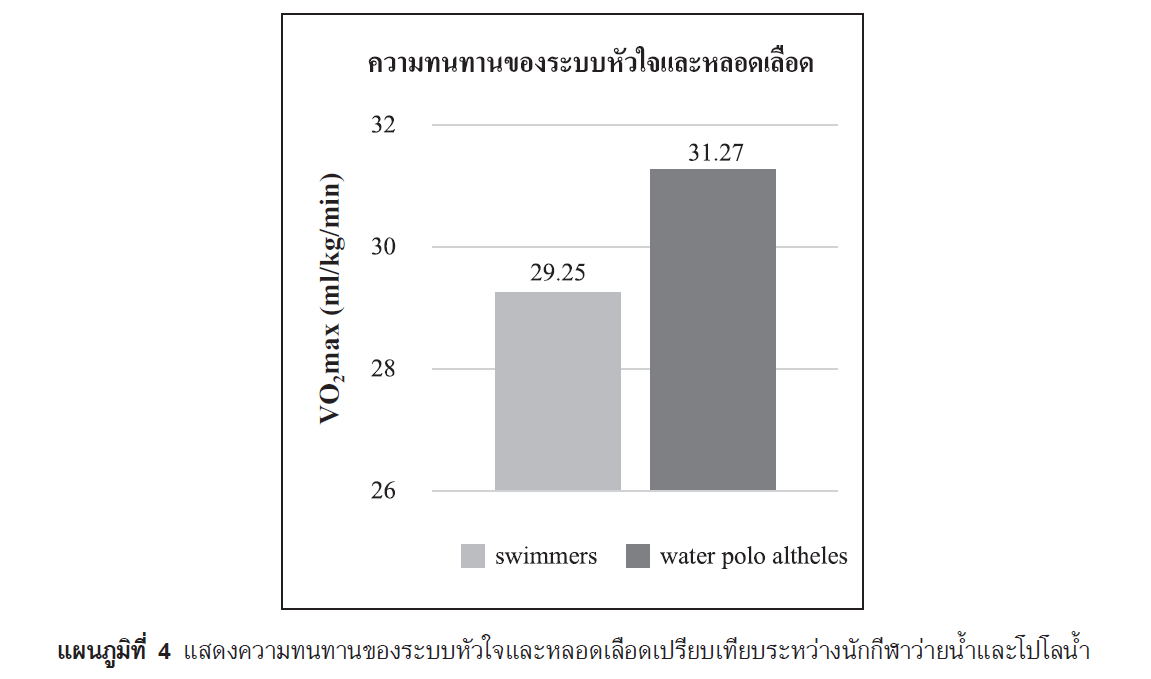A COMPARISON OF SELECTED PHYSICAL FITNESS MEASURES BETWEEN SWIMMERS AND WATER POLO ATHLETES IN THAILAND SWIMMING ASSOCIATION.
Main Article Content
Abstract
Purpose:
The purpose of this study was to compare physical fitness between swimmers and water polo athletes in Thailand swimming association.
Methods:
A total of 30 swimmer, aged betwee 14-23 years, voluntarily participated in this study. They consisted of 15 swimmers (11 male and 4 female) and 15 water polo athletes (11 male and 4 female). Physical fitness testing consisted of hand grip strength, lower extremity muscle power using standing long jump test, inspiratory muscle strength using maximum inspiratory pressure and cardiovascular endurance using the 12 minute run test.
Results:
The result found that there were no significant differences in all measure of physical fitness between swimmers and water polo athletes. However, while there was a trend for greater grip strength and inspiratory muscle strength in swimmers, there was a trend for higher leg muscular power and cardiovascular endurance in water polo athlete.
Conclusion:
Swimmers tend to have stronger lower upper extremity muscle strength and respiratory muscle strength while water polo athletes tend to have higher upper extremity muscles when compared to their peers. Such differences are related to the relative contribution of upper and lower extremity muscle as well as duration of competition for each sport.
Article Details
References
American Thoracic Society, E. R. S. (2002). ATS/ERS Statement on Respiratory Muscle Testing. 166, 528-542. Retrieved from https://www.thoracic.org/statements/ resources/respmuscle.pdf website: doi:10.1164/rccm.166.4.518
Apichart Onsoy, P. S. (2014). swimming (2 ed.). Nonthaburi: Temrakkranpim
Bebeley, S. (2015). An Investigation into the Measurement Level of Maximum Volume of Oxygen Consumption Using Cooper 12-minutes Run-test. Journal of Exercise Science and Physiotherapy, 11, 65. doi:10. 18376//2015/v11i2/67705
De, S., Sengupta, P., Maity, P., Pal, A., & Dhara, P. (2011). Effect of Body Posture on Hand Grip Strength in Adult Bengalee Population. Journal of Exercise Science and Physiotherapy, 7, 79. doi:10.18376//2011/ v7i2/67611
FM91BKK. (2019, 14 july 2020). Thai women water polo to start the first gold at the SEA Games 2019, winning 3 times Retrieved from http://www.fm91bkk.com/โปโลน้ำสาวไทย-ประเดิม-ทองแรกซี
Heinlein, S. A., & Cosgarea, A. J. (2010). Biomechanical Considerations in the Competitive Swimmer’s Shoulder. Sports health, 2(6), 519-525. doi:10.1177/1941738110377611
Heyward, V. H., & Gibson, A. (2014). Advanced Fitness Assessment and Exercise Prescription 7th Edition: Human Kinetics.
Karaula, D., Grcic-Zubcevic, N., & Jadresic, D. (2016). Differences in forced vital capacity between groups of elite Croatian swimmers, water polo players and breath hold divers. Sport Science 9, 18-21.
Kilding, A., Brown, S., & McConnell, A. (2009). Inspiratory muscle training improves 100 and 200 m swimming performance. European Journal of Applied Physiology, 108, 505-511. doi:10.1007/s00421-009-1228-x
Leelarungrayub., D. (2014). Clinical chest physiotherapy (3 ed.). Bangkok: Thammasat university bookstore.
Mansanguan, S. (1985). water polo (pp. 2-8). Retrieved from http://old-book.ru.ac.th/ e-book/inside/html/dlbook.asp?code=PE457 Retrieved from http://old-book.ru.ac.th/e-book/inside/html/dlbook.asp?code=PE457
Piranun Naksri, S. P. (2012). The Comparison of Breathing Technique in Crawl Stroke Distance 400 Meter. Journal of Education Khon Kaen University (Graduate Studies Research), 6(4), 77-82. Retrieved from
http://so02.tci-thaijo.org/index.php/EDGKKUJ/article/view/50744252 Journal of Sports Science and Health Vol.22 No.2, (May-August 2021)
Poproshaev, V., & Chumakov, V. (2014). Anatomicmorphological features of qualified water polo players depending on game role. Pedagogics, Psychology, Medical-Biological Problems of Physical Training and Sports,1. doi:10.6084/m9.figshare.894391
Rodréguez, F. (1994). Physiological testing of swimmers and water polo players in Spain. Medicine and Sport Science, 39, 172-172.
Siamsport. (2019, 14 july 2020). Thai women water polo to start the first gold at the SEA Games 2019, winning 3 times Retrieved from https://www.siamsport.co.th/seagames2019/news/view/162792
Tavorn Kamutsri, A. T., Chatchai Sriwilai, Jira Nabsanit. (2015). The Physical Fitness Norms of Thai University Athletes, Sports and Exercise Physiology, 15(2), 145-158.
Tsekouras, Y., Kavouras, S., Campagna, A., Kotsis, Y., Syntosi, S., Papazoglou, K., & Sidossis, L. (2005). The anthropometrical and physiological characteristics of water polo players. European Journal of applied Physiology, 95, 35-41. doi:10.1007/s00421-005-1388-2
Wood, R. (2008, 6 August 2021). Fitness for Swimming. Retrieved from https://www. topendsports.com/sport/swimming/fitnesscomponents.htm
Zinner, C., Sperlich, B., Krueger, M., Focke, T., Reed, J., & Mester, J. (2015). Strength, Endurance, Throwing Velocity and in-Water Jump Performance of Elite German Water Polo Players. Journal of Human Kinetics, 45, 149-156. doi:10.1515/hukin-2015-0015


